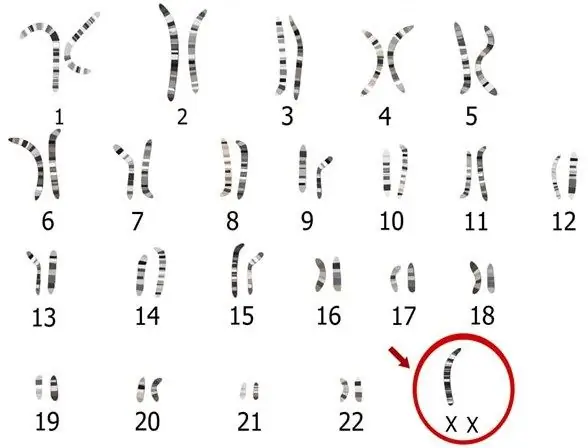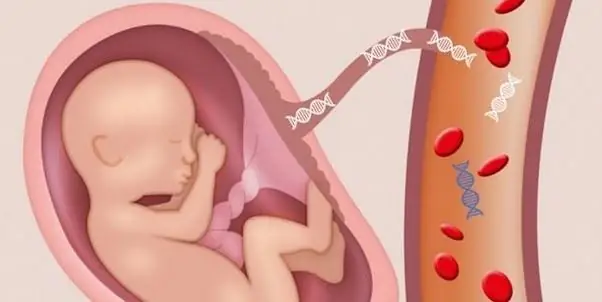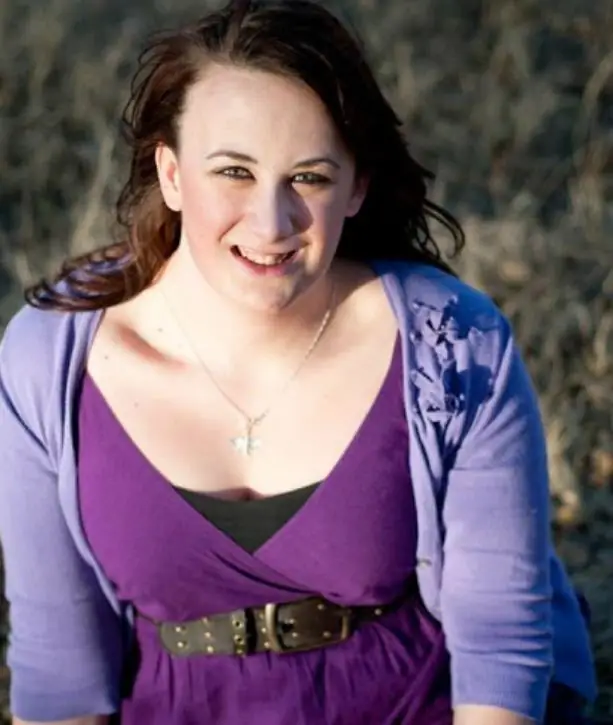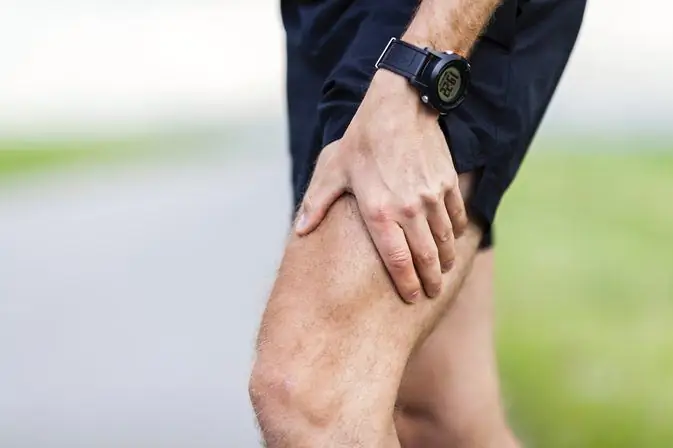- Author Curtis Blomfield [email protected].
- Public 2023-12-16 20:44.
- Last modified 2025-01-23 17:01.
Shereshevsky-Turner syndrome (also Ulrich-Turner syndrome) is a genetic disease caused by the complete or partial absence of one X chromosome in women. Like other chromosomal abnormalities, it is characterized by severe consequences for patients. The karyotype in Turner syndrome is designated as 45, X0.

Genetics
In short, Turner syndrome develops in the case of complete or partial monosomy of the X chromosome in a woman. In about 20% of cases, the disease is associated with X-chromosome mosaicism - a condition in which some cells of the female body have two normal X chromosomes, one of which is not active, and in other cells one of the sex chromosomes is significantly damaged or completely absent. Sometimes there is a transition of part of the X chromosome to an autosome (translocation).
In some cases, the syndrome is associated with the appearance of the so-called ring chromosomes or isochromosomes. Ring chromosomes occur when the ends of a chromosome break and their long and short arms jointogether to form a ring. Isochromosomes occur when a lost long or short arm of a chromosome is replaced by an identical copy of the other arm.
There have been cases in patients where some cells have only one copy of the X chromosome, while other cells have the X chromosome and some Y chromosome material. The amount of material on the Y chromosome is not enough to cause an organism to become male, but its presence is associated with an increased risk of developing a form of cancer known as gonadoblastoma.
More than 90% of pregnancies in the presence of Shereshevsky-Turner syndrome in the fetus end in miscarriage or stillbirth, about 15% of spontaneous abortions are associated with this pathology. However, it is worth noting that this is the only monosomy in the human body, which in some cases is compatible with life: monosomy on any autosome (non-sex chromosome) or Y chromosome inevitably leads to fetal death in the early stages of pregnancy. Proper medical care can relieve the symptoms of the disease in children born with Ulrich-Turner syndrome.

Symptoms of the disease vary greatly from patient to patient. Most patients are characterized by low growth due to pathologies of skeletal development, a short neck, underdevelopment of secondary sexual characteristics, pathologies of the organs of vision and the cardiovascular system, and infertility. Despite this list of symptoms, Turner's syndrome is far from the worst genetic pathology - the intellect in patients is usually preserved, and with the rightthe prescribed course of treatment, women with this genetic anomaly can lead a normal life.
Ulrich-Turner syndrome can be detected before birth using modern diagnostic methods, which will be discussed below. Unlike other genetic diseases, the syndrome is not inherited within families and appears spontaneously (sporadically).
Reasons
The causes of Shereshevsky-Turner syndrome are not yet well understood. It is not known exactly what factors affect the likelihood of having a child with this disorder. It has been hypothesized that the risk of developing the syndrome is affected by exposure of the mother to increased doses of ionizing radiation (more than 1 mSv per year). Large-scale studies related to identifying the causes of Turner syndrome and other chromosomal abnormalities were carried out in the 70s of the last century. The studies were carried out in the Indian state of Kerala, where the radiation background is significantly higher than the norm due to the presence of thorium and its decay products in the soil, and in the Chinese province of Guangdong, where the annual equivalent dose is 6.4 mSv. The results showed that increased doses of ionizing radiation increase the risk of having children with Down syndrome and crying cat syndrome. However, there was no increase in the incidence of Turner syndrome. Today, in many sources you can find information that ionizing radiation affects the risk of developing pathology, but there are no statistics that would confirm this.
No relationship was found between mother's age and the likelihood of having a child withthis pathology.
Symptoms
For patients with this disease are characterized by: short stature, pathology of the development of the skeleton and secondary sexual characteristics. The disease can also affect other organ systems. The presence of Shereshevsky-Turner syndrome does not mean that one patient will have all the possible signs of the disease. The syndrome is characterized by a wide range of symptoms and specific external features. The presence of certain symptoms, their severity and time of manifestation are strictly individual.
Most babies with Turner syndrome are born slightly premature and underweight. Newborns often experience swelling of the arms and legs. In many patients in adolescence, overweight or obesity appears, growth slows down, underdevelopment of the mammary glands and uterus, amenorrhea, chest deformity appear. Sometimes there are pathologies such as a horseshoe kidney, hypoplasia of the left heart, narrowing of the aorta, in adulthood - arterial hypertension.
Intellect in patients is usually normal, but there may be difficulties associated with concentration and memorization of new material. Some children with Turner Syndrome develop ADHD (Attention Deficit Hyperactivity Disorder) during childhood and adolescence.
Patients are at increased risk of hypothyroidism due to autoimmune thyroiditis. Some women with Turner syndrome have gluten intolerance (celiac disease).
Possible symptoms of the disease also include: high palate, low hairline, underdevelopment of the lower jaw. There are pathologies of the organs of vision and the urinary system.
Prenatal Diagnosis
It's no secret that modern diagnostic methods can detect most genetic abnormalities of the fetus long before birth. One such procedure, non-invasive prenatal testing (screening for fetal extracellular DNA found in the mother's blood), can be performed from the end of the first trimester of pregnancy.

The advantage of this procedure is that it is completely safe for the mother and fetus. In addition to Turner syndrome, extracellular DNA screening can detect aneuploidies such as Patau syndrome (trisomy 13), Edwards syndrome (trisomy 18), Down syndrome (trisomy 21), trisomy X., Klinefelter syndrome, Martin-Bell syndrome.
Ultrasound examination can detect abnormalities in the development of the kidneys and heart - they are among the possible symptoms of the disease.

Syndrome can be detected by amniocentesis or chorionic biopsy. Both of these procedures are invasive and have contraindications. Their advantages include high accuracy of the result.
Diagnosis in childhood and adolescence
The presence of Shereshevsky-Turner syndrome is not always found before childbirth. Many women who have a normal pregnancy do not consider it necessary to resort to prenatal diagnosis of genetic abnormalities of the fetus, some refuse itdue to contraindications or fear of side effects. Then the birth of a child with a chromosomal abnormality becomes a surprise for them.
In some cases, Turner syndrome in children can be diagnosed immediately after birth, while mild forms of the disease often go unnoticed by specialists and the child's parents until the onset of adolescence. It happens that the first three or four years of life the child develops normally. After that, growth slows down sharply, and the lag behind peers in physical development becomes noticeable. In elementary school, learning difficulties appear due to the inability to concentrate. Children with Turner Syndrome have a particularly difficult time with sciences that require a high concentration of attention and spatial thinking.
By the end of puberty, girls with this genetic anomaly are much shorter than their parents (the average height of women with Ulrich-Turner syndrome is 145 cm), skeletal anomalies and other symptoms of pathology are noticeable. To make sure that a child has a disease, you should contact a specialist who will offer to perform karyotyping, a diagnostic procedure that allows you to identify chromosomal abnormalities in the genome. This procedure is absolutely safe, painless and has no contraindications. During karyotyping, the researcher takes several cubes of venous blood for analysis and examines the mitotic cycle of leukocytes isolated from there.
Treatment
Currently, there are no procedures or drugs that have allowed the treatment of Turner's syndrome. Perhaps in the future genetictherapy will allow restoring the lost X chromosome during embryogenesis, but so far such procedures remain beyond the bounds of the possible. Treatment of Shereshevsky-Turner syndrome remains symptomatic. To correct short stature, hormonal preparations containing somatotropin are prescribed, which are taken before and during puberty. The sooner somatotropic therapy begins, the more effective it will be.
Estrogen replacement therapy has been used for more than seventy years for the normal development of secondary sexual characteristics in patients, it is prescribed at the age of 12-14 years. To maintain a normal balance of hormones in the body, most women require estrogen and progesterone before menopause.
Estrogen is also key to maintaining bone integrity and proper functioning of body tissues. Women with Shereshevsky-Turner syndrome without estrogen administration have an increased risk of osteoporosis and heart disease.
Hypothyroid patients are prescribed thyroid hormones.
If patients have diabetes, they need to constantly monitor the level of insulin in the blood and stick to a diet.
If a woman with Ulrik-Turner syndrome has a horseshoe kidney or urinary system defects, a nephrologist and urologist should be consulted.
Forecast
Prognosis, as with any genetic pathology, depends on the severity of the symptoms. Many women who have undergone hormone therapy live full lives. They are at normal levels.intelligence and learning ability.
Almost all patients with Turner syndrome are unable to have children. Medicine knows cases when such women could become pregnant on their own, but this is a rarity. Most patients solve this problem with the help of artificial insemination.
It should be remembered that women with Turner syndrome have an increased risk of complications during pregnancy. They require constant supervision by a gynecologist and a therapist.
Of course, a difficult fate for those who have been diagnosed with Turner's syndrome. A photo of a young woman suffering from this condition is shown below.

Prevalence
Ulrich-Turner syndrome is not a rare disease. Its frequency ranges from 1:2000 to 1:5000 in newborn girls, and given the fact that most pregnancies with this syndrome end in miscarriage or spontaneous abortion, we can say that the incidence of the disease is much higher.
No racial or ethnic factors have been identified that would affect the frequency of births of children with Turner syndrome.
Discovery history
The disease was first described independently by the Russian endocrinologist Nikolai Shereshevsky in 1925 and the American endocrinologist Henry Turner in 1938. They studied the main symptoms of the pathology, but did not assume that the disease they discovered was associated with a chromosomal abnormality. The German scientist Ulrich also contributed to the study of the disease. ATIn 1930, he described a clinical case when an 8-year-old patient had no secondary sexual characteristics, there was low growth, micrognathia (underdevelopment of the upper jaw). In European literature, this chromosomal anomaly is often referred to as Ulrich-Turner syndrome or simply Ulrich syndrome.
The first publication about a woman with a karyotype of Shereshevsky-Turner syndrome belonged to the British physiologist Charles Ford. It was he who determined that the cause of the syndrome is monosomy on the X chromosome.
Medical curiosity
There are two other diseases that are sometimes abbreviated as Turner's syndromes. These pathologies were discovered and described by the namesakes of the American endocrinologist Henry Turner, hence the confusion with the names. These are May-Turner and Personage-Turner syndromes. Both of these diseases have nothing to do with the monosomy of the X chromosome described above, and are not even hereditary diseases.
The first description of the May-Turner syndrome appeared in 1957. Pathology is manifested by a violation of the outflow of venous blood from the left lower limb and pelvic organs, as a result of which patients suffer from constant pain in the left leg and pelvic region. In the later stages of the disease, deep vein thrombosis is seen on venography. The syndrome is difficult to diagnose, especially in the early stages, as it is initially asymptomatic. May-Turner syndrome usually begins in adolescence and is more common in men than women.

As the main diagnostic procedure, ultrasound of the iliac veins of the pelvis is used. Whenthe presence of the disease, the left common iliac vein in diameter is much larger than normal. To confirm the diagnosis, magnetic resonance angiography of the iliac veins with contrast is used. In the later stages of the disease, treatment is performed surgically. Medications are often prescribed to restore normal blood flow.
Personage-Turner syndrome is rare in clinical practice and its causes have not yet been clearly established. The first signal about the presence of the disease is a sharp causeless pain in the shoulder or arm, less often in both arms at the same time. Many people who have this pathology for the first time do not consider it necessary to seek help from a specialist, hoping that the symptoms will disappear on their own.

Pain may not go away for days, sometimes weeks. The pain is aggravated by movement and subsides if the limb is at rest. Many patients stop developing their arm, which is why muscular dystrophy develops over time. For most people, the disease resolves over time without any intervention. Sometimes strong analgesics are required. The causes of the Personage-Turner syndrome are of great interest to physicians, but have not yet been studied. The prevalence of the disease is also unknown.






